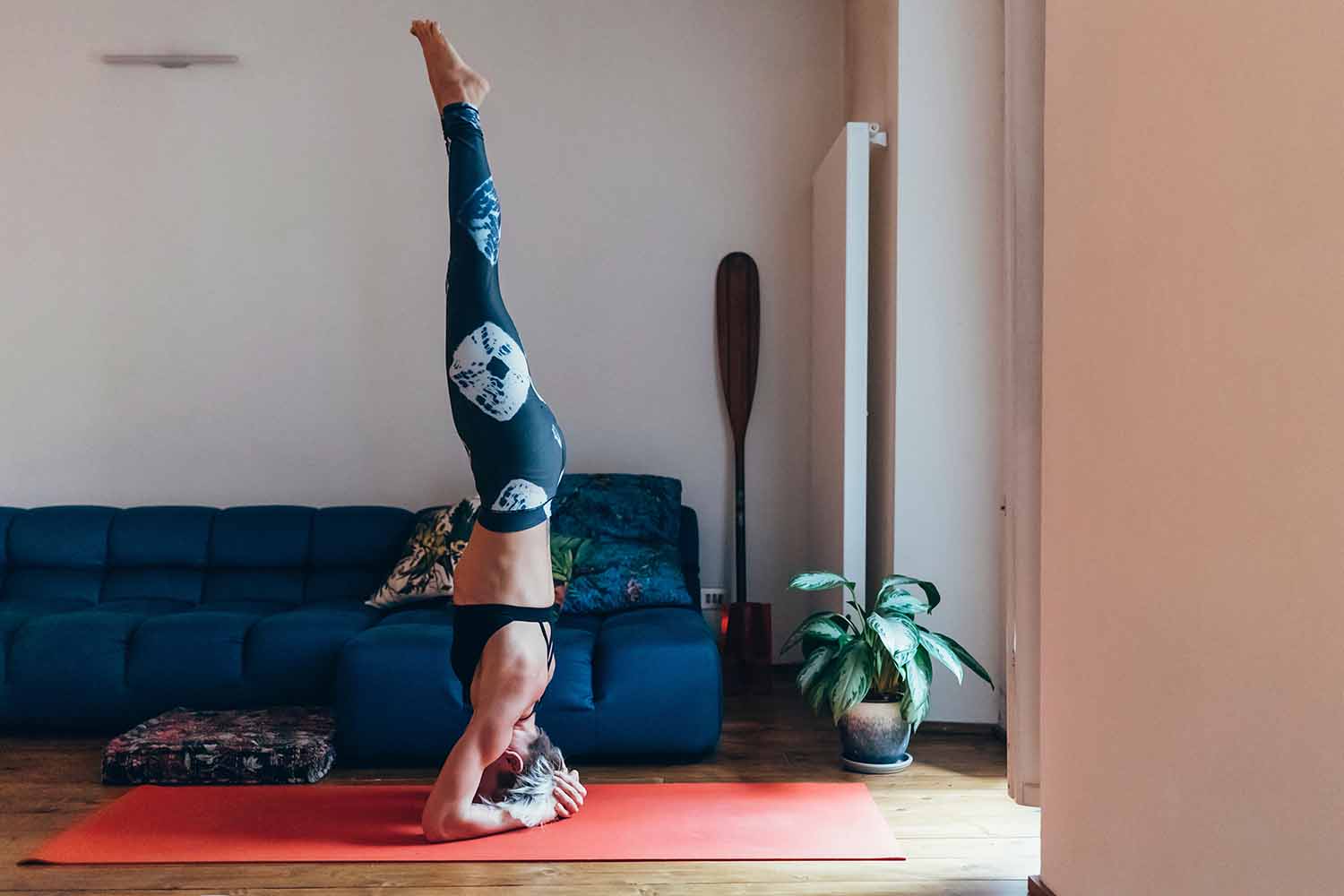Headstand Pose in yoga, or Sirsasana, is an inversion that builds strength and balance while improving mental clarity and focus. It involves balancing on the head with the legs extended upward, engaging the core and shoulder muscles to maintain stability. The pose can be adjusted with modifications to suit different skill levels, and it offers numerous benefits, such as improved circulation and concentration. Understanding the correct technique, potential modifications, and precautions can help practitioners safely incorporate Headstand Pose into their practice.
Other Names for Headstand Yoga Pose:
- Sirsasana (Sanskrit)
- King of Asanas
- Head Balance
- Kapalasana (Forehead Pose)
How to do Headstand Pose in Yoga:
- Begin in a kneeling position with your hands interlocked, creating a stable base for your head.
- Place the crown of your head on the mat, forming a triangle with your hands and head.
- Walk your feet toward your head, lifting your hips toward the ceiling.
- Gradually shift your weight onto your head and forearms, keeping your neck elongated.
- Slowly extend your legs upward, engaging your core muscles for balance.
- Maintain a straight line from your head to your heels, with toes pointing towards the sky.
- Balance is key. Engage your core, press your forearms into the mat, and avoid overarching your back.
- Focus on a point on the floor to enhance stability.
- To exit, bend your knees and lower them towards your chest with control.
- Gently return to the starting kneeling position.
Variations of Headstand Yoga Pose:
Tripod Headstand:
- Place the back of your head into your hands, creating a tripod with your hands and head.
- Lift your knees off the ground, extending one leg at a time.
Bound Headstand:
- Clasp your hands behind your back while in Headstand, adding an element of shoulder opening.
Modifications for Headstand Yoga Pose:
- Practice against a wall for added support.
- Use a yoga block between your hands to maintain alignment.
- Perform the pose with a spotter, especially for beginners.
Contraindications for Headstand Pose in Yoga:
- High blood pressure
- Neck injuries
- Menstruation
- Pregnancy
- Glaucoma
Tips to Improve Headstand Yoga Pose in Your Practice:
- Build Core Strength: Strengthen your core through specific exercises to enhance stability.
- Gradual Progression: Progress at your own pace, gradually increasing the duration of your Headstand.
- Focus on Alignment: Ensure your head, arms, and spine are aligned to avoid unnecessary strain.
What Muscles Does Headstand Pose Work?
- Core Muscles: Engaged to maintain balance.
- Shoulders and Arms: Support the weight of the body.
- Neck Muscles: Strengthened as they provide stability.
Mental and Emotional Benefits of Headstand Pose in Yoga:
- Increased Focus: Enhances concentration and mental clarity.
- Stress Relief: Inversion promotes relaxation and reduces stress.
- Confidence Boost: Mastering Headstand builds self-confidence.
Suitability for Beginners:
With proper guidance and modifications, beginners can gradually incorporate Headstand into their practice.
Suitability for Advanced Practitioners:
Headstand serves as a foundation for more advanced inversions and transitions.
Contribution to a Yoga Sequence or Flow:
- Energizing the Body: Headstand can be included at the beginning of a sequence to invigorate the body and mind.
- Closing a Sequence: Alternatively, it can be placed at the end of a sequence to wind down and promote relaxation.
How Can I Deepen My Practice in Headstand Pose?
- Practice Regularly: Consistent practice builds strength and confidence.
- Explore Variations: Experiment with different Headstand variations to challenge yourself.
Common Mistakes in Teaching Headstand Yoga Pose:
- Poor Foundation: Inadequate hand placement or a weak base can compromise the pose.
- Neglecting Alignment: Overlooking proper head, arm, and spine alignment can lead to injuries.
- Insufficient Warm-up: Skipping a proper warm-up may increase the risk of strain on the neck and shoulders.
In conclusion, Headstand Pose in yoga is a powerful inversion that offers both physical and mental benefits. Whether you are a beginner or an advanced practitioner, approaching this pose with mindfulness, proper technique, and respect for your body will help you unlock its full potential in your yoga practice.
What are the benefits of headstand pose?
The benefits of headstand pose include improved circulation, increased core strength, and enhanced focus. Practicing Sirsasana—the Sanskrit name for headstand—can stimulate the pituitary gland, promote lymphatic drainage, and help build upper body stability, often complemented by yoga tools like mats and wall supports for alignment.
How to do headstand for beginners?
To do a headstand for beginners, start in a kneeling position and form a tripod base by placing your forearms and head on a yoga mat. Engage your core, lift your hips, and slowly raise your legs using a wall for support. Practice the Sirsasana pose with guidance from yoga instructors or guided routines.
How long to hold a headstand pose?
A headstand pose, or Sirsasana, can typically be held for 10 to 30 seconds for beginners, gradually increasing to 1–3 minutes with experience. Practicing under guidance from a certified yoga instructor and using props like a yoga mat or wall support helps ensure safety and balance.
What happens if you do a headstand every day?
Doing a headstand pose every day may improve circulation, strengthen core and shoulder muscles, and enhance balance and focus. Regular practice of Sirsasana, a common yoga inversion, also supports lymphatic drainage and spine alignment when done properly and under guidance to prevent neck strain.
Do headstands build muscle?
Yes, headstands can help build muscle by engaging the core, shoulders, arms, and back. The headstand pose, or Sirsasana, activates stabilizing muscles and improves upper body strength. Practicing inversion poses like headstands in yoga strengthens muscles through isometric holds and bodyweight support.
When should you avoid headstands?
You should avoid headstands if you have high blood pressure, glaucoma, neck injuries, or are pregnant. The headstand pose (Sirsasana) places pressure on the cervical spine and eyes, making it risky for certain conditions. Always consult with a qualified yoga instructor or healthcare provider before practicing inversions like this asana.
What’s easier, a headstand or a handstand?
A headstand is generally easier than a handstand because it requires less upper body strength and balance. The headstand pose (Sirsasana) allows for more contact points with the ground—head and forearms—offering greater stability, unlike handstands which rely solely on wrist and shoulder strength for support.
What are the disadvantages of headstand?
The disadvantages of headstand pose include increased pressure on the cervical spine, risk of neck injury, and elevated intraocular pressure. Inversions like Sirsasana can also strain the cardiovascular system and are not recommended for individuals with glaucoma, high blood pressure, or spine issues.

